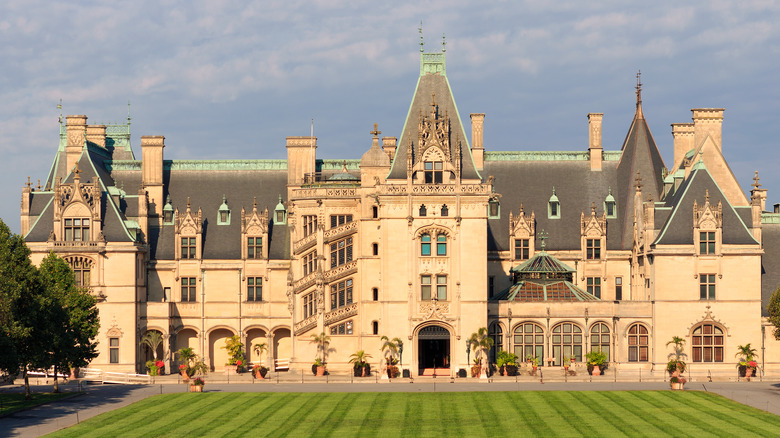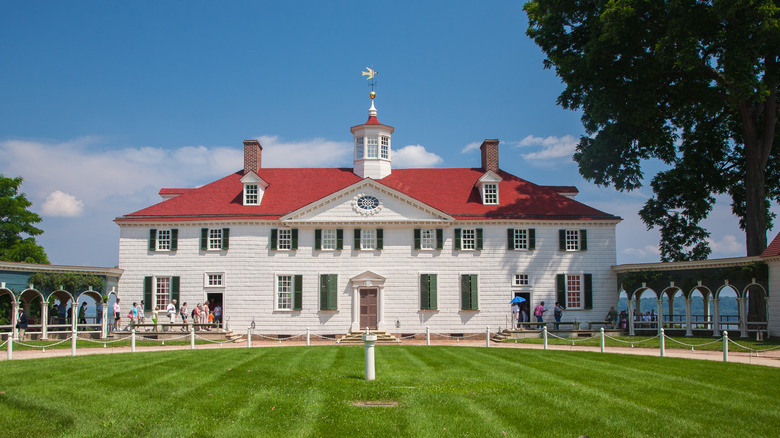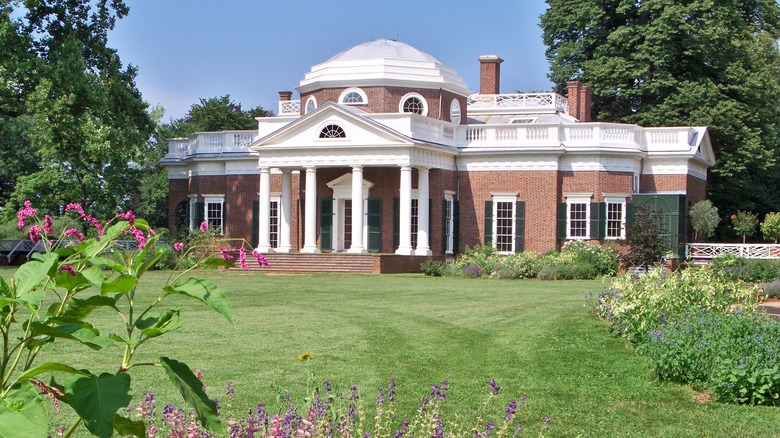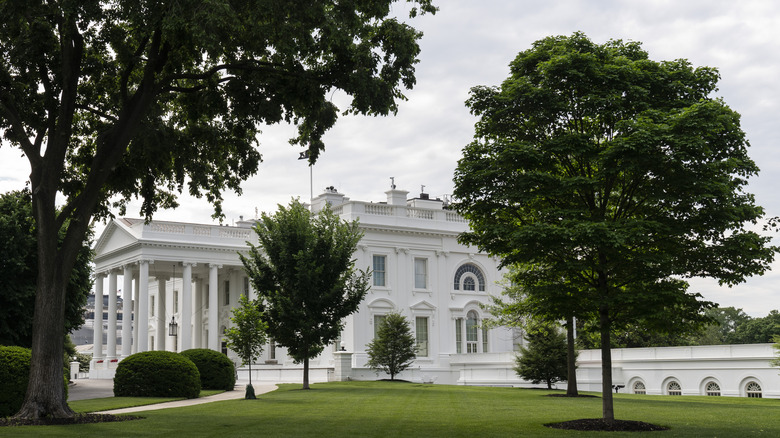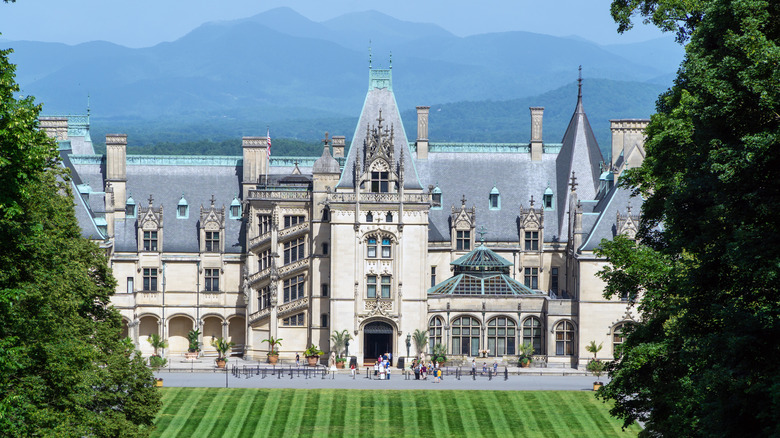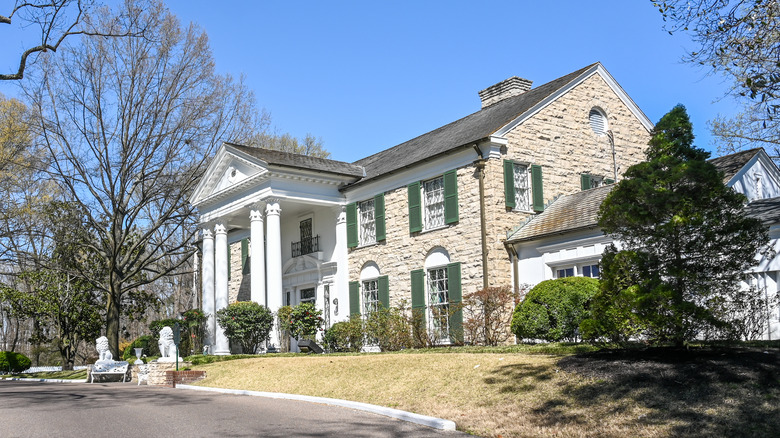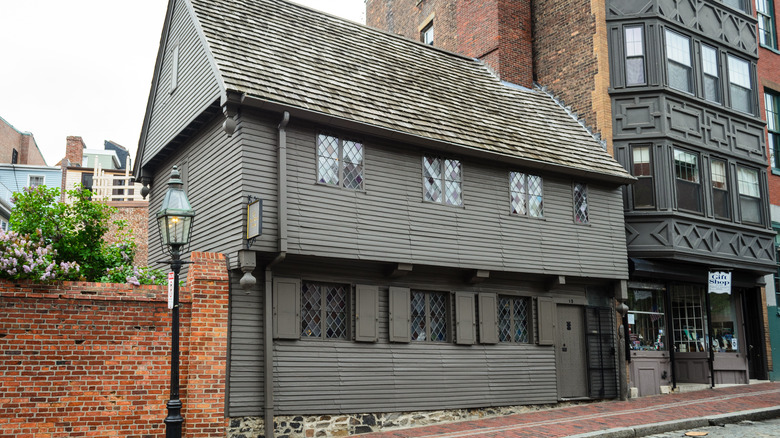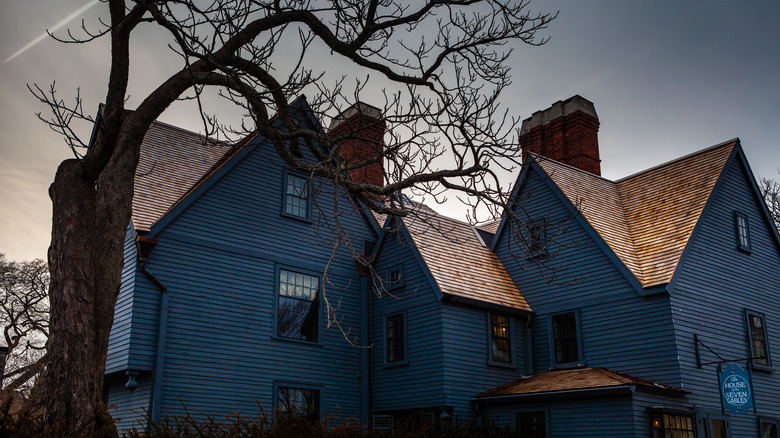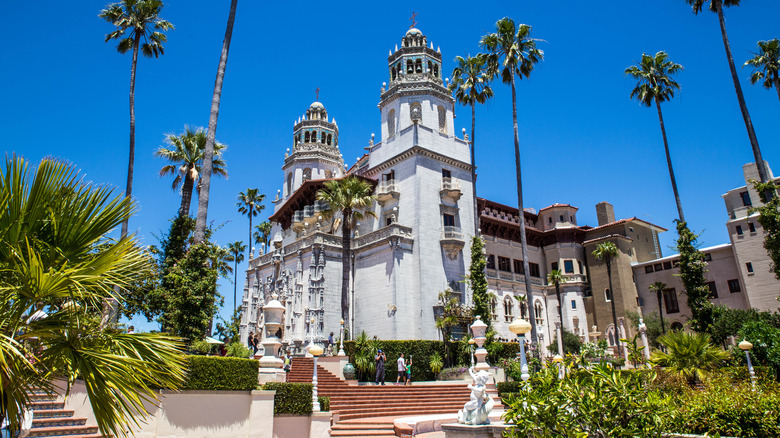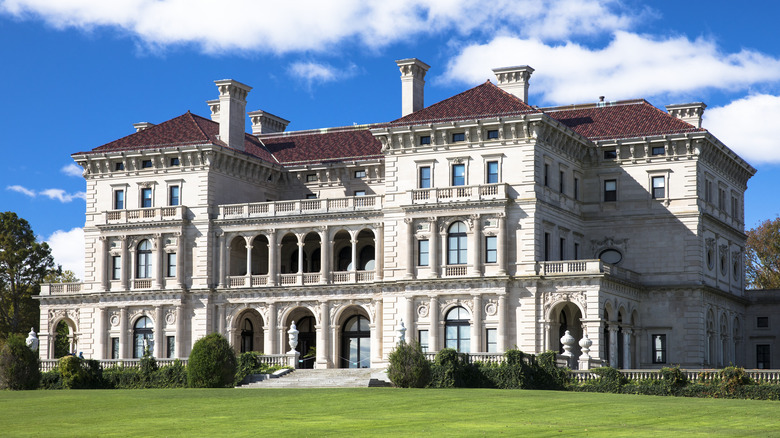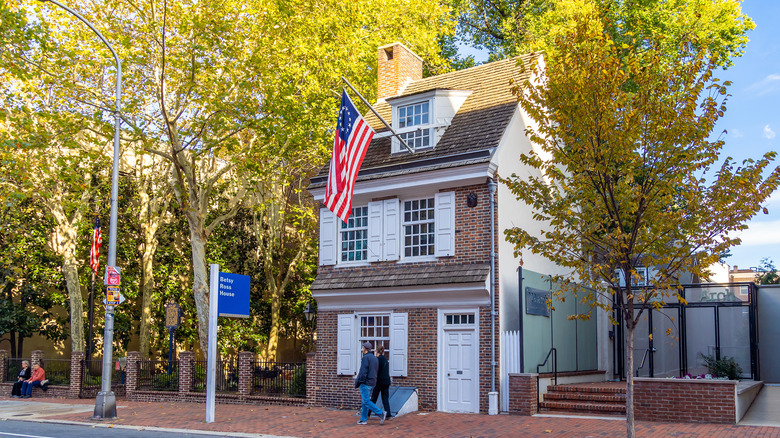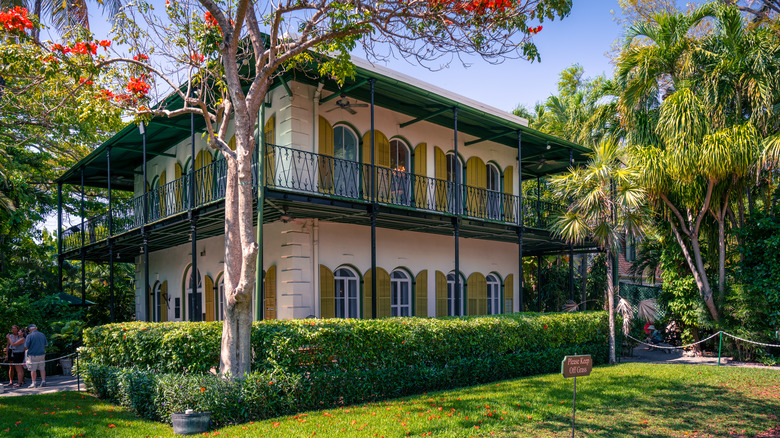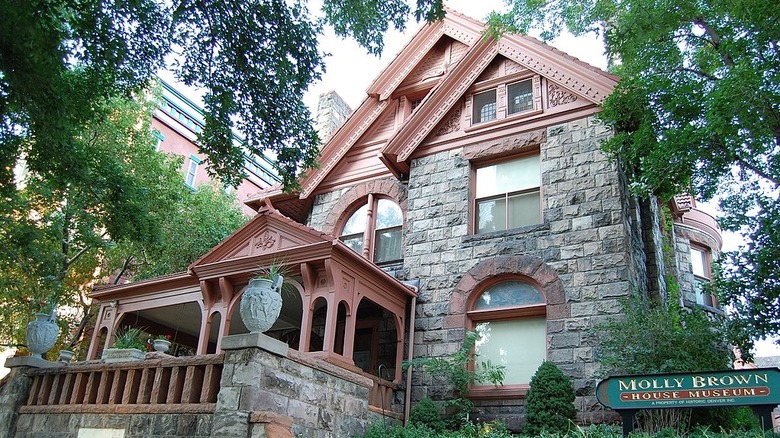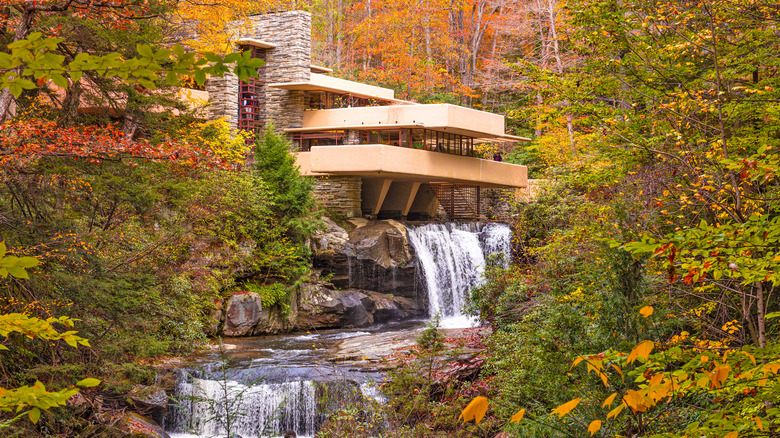The Most Famous Historic Homes In America
Although the United States is a much younger country than many others, it has more than its share of exquisite homes that are full of history. Constructed over the span of four centuries, from the 1600s through the mid-1900s, in almost every architectural style — including the utilitarian clapboard homes of the early settlers to the Classical Revival mansions of the nation's first presidents to French chateaux — the U.S. boasts some of the most interesting historic homes anywhere.
All of these important buildings represent the extraordinary people who lived in them and all of them are open to the public. Some historic homes were also designed by those who lived in them, using their genius to create masterpieces of architecture in the new American wilderness. Others were home to men and women who distinguished themselves in the realm of politics, business, and philanthropy, whose homes are testaments to their outsized lives in the heady days when the U.S. was expanding westward. And some are shrines to beloved entertainers whose appeal is eternal. Here are some of the most famous historic homes in America.
George Washington's Mount Vernon
Mount Vernon, the home of George Washington, located just outside Alexandria, Virginia, is one of the most visited buildings in the nation. With its understated architecture harkening back to its owner's origin as a farmer, it exemplifies the man who once worked as a land surveyor and became a beloved general in the American Revolution before becoming president.
However, built starting in 1734 by the future President's father, Augustine Washington, the home is 10 times larger than the average Colonial home of the era, according to the Mount Vernon Ladies' Association of the Union, the nonprofit institution that operates the house. After George Washington assumed ownership of the home, he enlarged it to 21 rooms, taking great care in overseeing the design and decor, despite being frequently absent from his beloved retreat. The mansion was expanded under George's watchful eye to encompass an impressive 11,000 square feet, while the graceful, two-story piazza, with eight columns, prompted Mount Vernon to become one of the most copied homes in the United States.
Incredibly, Mount Vernon was near collapse before it was rescued in 1853 by the Mount Vernon Ladies' Association, a group of women who were determined that the home be saved for posterity; incredibly, they still own and operate it today, Forbes relates. Now restored to its original grandeur, the elegant home with its gracious gardens is one of the most-visited sites along the historic Potomac River.
Thomas Jefferson's Monticello
Thomas Jefferson, who once said "Architecture is my delight, and putting up and pulling down, one of my amusements," according to Monticello.org, was a genius whose mind encompassed horticulture, science, politics, and architecture, among other disciplines. The designer of Monticello (meaning "Little Hill"), Jefferson later demolished parts of the Palladian and Neoclassical masterpiece, renovating it repeatedly.
Featuring an oculus, or circular window at the top of a dome, and 12 other skylights, Monticello has 43 rooms, according to The Thomas Jefferson Foundation, which operates the estate. Jefferson was a noted gardener as well; his vegetable and flower gardens, which are open to the public, functioned as an experimental laboratory for plants he imported from around the globe. Of course, few of his brilliant plans could have been carried out without the labor of enslaved people; only some of them were freed in his will.
One of the most profligate of presidents in his private life, Jefferson's pocketbook could never keep up with his architectural dreams; by the time he died, on July 4, 1826, he was more than $100,000 in debt, according to The Saturday Evening Post. As the National Park Service relates, Monticello, which was recognized as an architectural treasure from its inception, was finally acquired by the Thomas Jefferson Memorial Foundation in 1923 so that it would be maintained and opened up to the public.
The White House
The White House, which serves as both the home and the office of the president of the United States, has pride of place as the most famous residence in the country. Designed by the Irish architect James Hoban, its location was chosen by George Washington and it was constructed beginning in 1792, according to White House historical records, at a time when the moving of the U.S. capital from Philadelphia to Washington, D.C. was still controversial, as related by The Constitution Center.
Burned down by the British during the War of 1812, the Neoclassical building stands today as a testament to the vigor of the young country. After it was rebuilt (under the direction of Hoban, as reported in History), it went on to epitomize American military and political power. Although having a total of 132 rooms, including the elegant Oval Office, as well as the ornate Truman balcony overlooking the South Lawn, the White House has the clean, unostentatious lines of a Neoclassical-style building. It is not meant to be as ornate or pretentious as a palace; indeed it was meant to embody the new nation as a house of the people.
The Biltmore Estate
This French chateau in North Carolina's Blue Ridge Mountains is the largest family home ever constructed in the United States and one of the most spectacular buildings in the country. Built between 1889 and 1896 at the height of The Gilded Age, it has an astounding 250 rooms, 60 fireplaces, 35 bedrooms, three kitchens, an indoor pool, and a sumptuous banquet hall that seats 64, per Deutsche Welle; the many gardens on its 75 acres were created by the famed landscape architect Frederick Law Olmsted.
Situated on 8,000 acres, it was built with the vast sums of money earned by Cornelius Vanderbilt's investments in the steamship and railroad industries, which were exploding as the country expanded west in the 1800s, as Biography relates. Since Vanderbilt was a completely self-made man, his enormous home exemplifies the American entrepreneurial spirit in the booming decades of the late 1800s.
The family's fortunes even survived the Great Depression, and they continued to live at the home until the 1950s, when they began to run it as a business, giving tours and renting it out for special occasions. The fourth generation of the Vanderbilts still operates Biltmore as a wedding venue, ultra-upscale hotel, and equestrian center, attracting an incredible 1.7 million visitors every year. As Bill Cecil, the great-grandson of Cornelius and Edith Vanderbilt says on the estate's website, "We are still passionate about our mission of preservation through self-sufficiency." Now, this also includes winemaking and a line of luxury home furnishings.
Elvis Presley's Graceland
Graceland occupies a special place in the panorama of America's most historic homes. As The Society of Architectural Historians' site Archipedia notes, it was built in 1939, in part to show off the abilities of the original owner's daughter, as the music she played in its front rooms spilled onto the lawns. Its elegant, Classical Revival architecture is notable in itself, but it has of course gone down in history for the place that its later owner, Elvis Presley, occupies in the hearts of music lovers all around the world.
Luxurious rooms with white furniture, enormous mirrors, and stained glass windows portraying peacocks are a time capsule of the 1960s-1970s décor at Graceland. It epitomizes the beloved entertainer, who had been born with nothing and could indulge his tastes in everything he cared to own.
With its stately columns welcoming his many guests, Graceland is Elvis at his ostentatious prime – yet it shows his personal side as well, with his famous "Jungle Room" reminding him of the happy times he had while filming in Hawaii, Graceland says. The many exhibits at Graceland include one on Tupelo, Mississippi, where "The King" was born, and another showing how his music influenced many notable musicians such as Bruce Springsteen, Elton John, and Jimi Hendrix. True fans can pay their respects to Elvis at his gravesite in the Meditation Garden, located in Graceland's courtyard.
The Paul Revere House
Located a stone's throw from the skyscrapers of Boston, in the city's North End — now a tourist mecca of fine restaurants — the Paul Revere House stands proudly as the only remaining structure from the 1600s in the area, its official website states. Built in the garrison style, the home of the man who rode out of Boston to warn his fellow colonists of the approach of British troops on April 18-19, 1775, has been restored to its condition when Paul Revere lived there.
As Biography relates, the famed patriot was born the son of a French Huguenot immigrant father named Apollos Rivoire. After becoming a successful goldsmith and silversmith, Revere became embroiled in the Revolutionary movement when he acted as a courier for the Boston Committee of Safety and helped plan the Boston Tea Party, which took place in December 1773.
Built in 1680, the house was where Revere lived with his family from 1770 to 1800, according to the historians at the Paul Revere House. Incredibly, over the years, it had been used as the location for a vegetable and fruit business, a candy store, a tenement for immigrants, a cigar factory, and even an Italian bank, before it was rescued from the wrecking ball in 1902.
The House of the Seven Gables
Now part of a National Historic Landmark District, the House of the Seven Gables, the setting for American writer Nathaniel Hawthorne's novel penned in 1851, is an imposing mansion built in 1668. Constructed in the Jacobean/Post-Medieval style, it is "one of the largest timber-framed mansions in North America still on its original foundation," according to the nonprofit that operates tours and educational seminars at the home.
Located in Salem, Massachusetts, one of the most historic towns in America, the House of the Seven Gables was built for Captain John Turner, the scion of a seagoing family which helped create the maritime tradition of New England, the Salem Witch Museum states. Hawthorne, the great-great-grandson of John Hathorne, the judge at the Salem With Trials, set his novel at the enormous mansion, which belonged to a distant cousin.
The house has been renovated several times but the original Jacobean structure still survives, more than 350 years after it was built.
Hearst Castle
The magnificent Hearst Castle, built for newspaper mogul William Randolph Hearst, is undoubtedly one of the most spectacular of any historic home in America. Perched like a European castle atop a hill in San Simeon, California, called "La Cuesta Encantada" or "the Enchanted Hill," by its owner, its elegance and beauty put it on an equal footing with some of the finest castles on the Continent.
And indeed many features of the Hearst Castle were imported from Europe – including an entire 15th-century ceiling, which Hearst had shipped from Spain – as well as countless works of art that adorn all of its interior and exterior spaces. Greek and Roman antiquities grace the property, where Hearst hosted the cream of society and business moguls for epic weekends. The 345,000-gallon Neptune Pool is finished with handmade tile in a Greek key motif and is surrounded by colonnades and outbuildings with Greek pediments, as Travel and Leisure describes.
The 127-acre estate, which includes the main building with twin towers, three separate guesthouses, and acres of terraced gardens, dotted with fountains and pools, is a testament to the grandiose dreams of Hearst, the millionaire newspaper magnate who built it as a home for himself and his wife Millicent, a former chorus girl, as History relates.
The Breakers
One of the most stunningly beautiful of all the great stone mansions of Newport, Rhode Island, The Breakers was constructed for Cornelius Vanderbilt II, the son of the scion of the Vanderbilt family who had built his own French chateau-styled mansion, "Biltmore," in North Carolina with the proceeds from his steamship and railroad fortune.
The construction of this imposing structure signaled the beginning of the grandest era for Newport at the start of the Gilded Age, when multimillionaires built sumptuous summer homes to escape the noise and heat of the city, according to Newport Mansions. Like so many other historic homes from that era, it epitomizes the staggering wealth that was earned by entrepreneurs in the times before income taxes (not to mention workers' rights) began to be imposed in the U.S.
Constructed in the Italian palazzo style, it has elements of the Italian Renaissance with classical Roman influences. The home's Music Room was constructed in France, then disassembled and reassembled in The Breakers. Other over-the-top touches include the platinum leaf in the Morning Room and the Baccarat crystal chandeliers that light the exquisite home, Newport Mansions relates. Diamonds, rubies, and other precious gems embellish the walls of The Breakers, according to a story in U.S. & World Report.
The Betsy Ross House
This historic home belonged to the woman who — legend claims — played a prominent part in the founding of the nation, providing the flag for the colonies to rally around. As Historic Philadelphia relates, at a time when supporting the Revolution would place anyone in peril, at risk of arrest — or worse — at the hands of the British, she allegedly created the 13-star flag that represented the upstart new nation of the United States in the year 1776.
Located in the Historic District of America's first capital city, the Betsy Ross House, built in 1740, offers a glimpse into a woman who is much more than the one-dimensional figure seen in history books. Twice widowed by the age of 30, she worked as an upholsterer and seamstress out of the house, where she lived in a rented room upstairs while plying her trade in a shop downstairs, according to Historic Philadelphia.
Like so many other historical homes in America, the Betsy Ross House was almost lost to development at one point. As The Independence Hall Association states, it was rescued from this fate in 1898, when 2 million Americans donated dimes to the Betsy Ross Memorial Association to save the building from being demolished or relocated. Today, this home to a beloved American female patriot still stands as a monument to a great moment in American history.
The Hemingway House
The iconic American author Ernest Hemingway had homes in several locations, but his retreat in Key West is especially historically significant since it was where he wrote parts of "For Whom the Bell Tolls," "Death in the Afternoon," and the short story "The Hills of Kilimanjaro," according to Independent Travel Cats. The base for his many epic deep-sea fishing expeditions in the Gulf of Mexico, which formed many of the ideas for his novels "To Have and Have Not" and "The Old Man and the Sea," it is now one of the most-visited historic homes in the U.S.
Of course, perhaps the estate is most renowned for its free-roaming army of polydactyl cats, either all or most of whom are descended from "Snow White," a cat with six toes that was given to him by a Cuban sea captain, according to The Hemingway Home.
As he was a larger-than-life figure in every way, Hemingway's home in the Keys was accordingly renowned for its lavish seawater swimming pool — created by digging down into solid coral – whose waters were lit up at night like an emerald. Constructed at a time when there was no fresh running water in Key West, the pool had to be filled with a salt-water pump that operated for two entire days, as The Hemingway Home relates.
The Molly Brown House
The home of "The Unsinkable" Molly, or Margaret, Brown, whose outsized life was stranger than fiction in many ways, is a testament to her indomitable personality. Known as "The Heroine of the Titanic" for manning the oars of a lifeboat and helping to save the passengers in it, she had first entered married life as a mining engineer's wife in hardscrabble Colorado, per the Molly Brown House. The opulence of her home shows the incredible wealth accrued by these first miners.
Molly Brown was aboard the Titanic when it hit an iceberg on April 14, 1912; forced to board a lifeboat, she and the other women on the boat took turns rowing and encouraging each other throughout that harrowing night. As Encyclopedia Titanica tells the story, once safely aboard the Carpathia, Brown took a leading role in organizing relief for the other survivors. She famously quipped in a letter to her daughter, "After being brined, salted, and pickled in mid-ocean, I am now high and dry."
The woman who once declared, "I am a daughter of adventure," had a home that epitomized her larger-than-life personality, with artifacts she collected from her many travels. Slated for demolition in 1972, the house was saved and restored by the group Historic Denver, as related by the museum; now listed on the National Register of Historic Places, it is one of the best examples of Victorian-era homes in the city.
Frank Lloyd Wright's Fallingwater
Even those who aren't fans of modern architecture in general can appreciate the stunning design of Fallingwater, the home designed by Frank Lloyd Wright, the American architect who stunned the world with his bold design that nestled the home in the rocks above a waterfall, seemingly becoming a part of the landscape itself.
Designed for the Kaufman family beginning in 1936 as a weekend retreat in the mountains of Pennsylvania, according to Fallingwater, the home pioneered the use of concrete cantilevers in home construction; although it later fell victim to weathering and other stresses, as related by the American Institute of Architects, the cantilevers made the homeowners feel they were virtually part of the waterfall, a concept that would become common in architecture from that point onward.
The home's design immediately became a sensation, featured in a 1938 exhibition at the Time-Life Building in New York; one year later, Fallingwater officials relate, Albert Einstein visited the Kaufmanns at the home.
